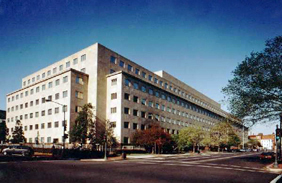How GAO Built Its Dream House
| Return to Table of Contents | < Previous Chapter |
Chapter 13, The "Dream House" Becomes a Model Building
 In December 1995, the GAO building
was named to the National Register of Historic Places as a symbol of modern block-type federal office design. Architectural historians of the National Park Service concluded that the
building warranted recognition because it exemplified American federal design at mid-century:
In December 1995, the GAO building
was named to the National Register of Historic Places as a symbol of modern block-type federal office design. Architectural historians of the National Park Service concluded that the
building warranted recognition because it exemplified American federal design at mid-century:
"Its exterior is characterized by the repetition of simple, rectangular forms in both the massing and fenestration, by overall symmetry of arrangement, by the minimal detailing, and by the uniformly horizontal emphasis . . . . In addition to introducing a modern style of architecture for the federal government, the GAO building is an important example of a new type of federal office building. Its construction marked a distinct break from the 'fishbone' type of office building which used either interior courts or a series of wings branching from a central spine in order to provide both air and light. . . . The place of the GAO building established a model that would be followed for both federal and private office buildings throughout Washington, D.C." In assessing GAO's headquarters building, architectural historians Laura V. Trieschmann and Laura H. Hughes wrote that the building displayed "distinctive construction techniques and decorative motifs that were characteristic of the mid-20th century." They noted in 1995 that forty-four years after it opened for business, the "GAO Building is in exceptional structural condition and remains essentially intact despite a few modifications required to increase building security." Trieschmann and Hughes concluded that "the fusion of new aesthetic ideas, new structural ideas, and new technological ideas into a single building marks a significant step in federal design. The GAO building represents the beginning of a new age."
From the time GAO's headquarters opened in 1951, the agency's officials have taken care to preserve the building's character while providing staff with a comfortable work environment. With the completion of the recent modernization effort, the building once hailed as a "dream house" will continue to serve GAO well for many years to come.
As has its building, GAO has adapted to changing times while retaining its fundamental character. Under Comptroller General David M. Walker, GAO remains committed to core values of accountability, integrity and reliability. GAO’s reports cover everything from the challenges of an aging population and the demands of the information age to emerging national security threats and the complexities of globalization. By examining federal programs and operations, GAO helps ensure that the government is answerable to the American people.
The modern GAO relies on a workforce of highly trained professionals who hold degrees in many academic disciplines, such as
accounting, law, engineering, public and business administration, economics, and the social and physical sciences. As Comptroller General Walker has noted, “the agency that once checked government vouchers has become a
multidisciplinary professional services organization equipped to handle the Congress’s toughest audit and evaluation assignments.”
| Return to Table of Contents | < Previous Chapter |

